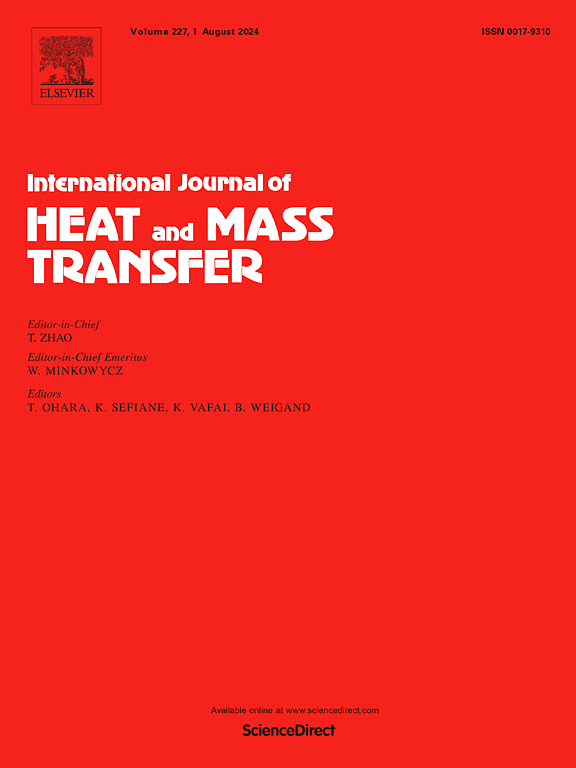微结构表面上非各向同性正戊烷/正己烷混合物池沸特性的实验研究
IF 5.8
2区 工程技术
Q1 ENGINEERING, MECHANICAL
International Journal of Heat and Mass Transfer
Pub Date : 2024-11-07
DOI:10.1016/j.ijheatmasstransfer.2024.126415
引用次数: 0
摘要
混合烷烃被广泛用作天然气液化等应用中的制冷剂,尤其是在浮式液化天然气(FLNG)工艺中。为了阐明混合制冷剂中相变弱化的机理并开发增强传热的方法,本研究建立了一个池沸腾实验装置,以研究正戊烷/正己烷混合物在三种不同微结构表面上的沸腾传热特性。通过直观观察气泡动态,分析成分条件、微观表面几何形状和壁面热通量条件对沸腾传热特性的影响,结果表明,与光滑表面相比,金字塔表面和圆柱表面的传热系数(HTC)最大分别增加了 345 % 和 203 %。与纯组分相比,正戊烷质量分数为 0.5 的混合物的传热系数下降幅度最大。微结构表面大大提高了混合制冷剂的 HTC。此外,微结构激活了更多的成核点和更高的气泡离去频率。金字塔表面的导向作用有效降低了气泡在高 Eo 值和 Ga 值条件下聚集的可能性,从而延缓了蘑菇状气泡的形成。因此,金字塔表面在不同的组分比例下都显示出其优势。针对纯制冷剂和混合制冷剂建立了 HTC 相关性。对纯制冷剂和混合制冷剂 HTC 的预测与大部分实验数据一致,偏差分别为 ±10 % 和 ±25%。本文章由计算机程序翻译,如有差异,请以英文原文为准。
Experimental study of pool boiling characteristics for non-azeotropic mixtures n-pentane / n-hexane on microstructure surfaces
Mixed alkanes are widely used as refrigerants in applications such as natural gas liquefaction, especially in the Floating Liquefied Natural Gas (FLNG) process. To elucidate the mechanisms underlying the weakening of phase transition in mixed refrigerants and to develop enhanced heat transfer methods, a pool boiling experimental setup is established in this study to investigate the boiling heat transfer characteristics of n-pentane/n-hexane mixtures on three different microstructure surfaces. By combining visual observation of bubble dynamics with analysis of the effects of composition conditions, micro-surface geometry, and wall heat flux conditions on the boiling heat transfer characteristics, it is revealed that the heat transfer coefficient (HTC) on the pyramid surface and the cylindrical surface, compared to the smooth surface, maximum increase by up to 345 % and 203 %, respectively. Compared with pure components, the mixture with a mass fraction of 0.5 n-pentane shows the greatest heat transfer deterioration. Microstructure surfaces significantly enhanced the HTC of the mixed refrigerants. Additionally, the microstructures activate more nucleation sites and higher bubble departure frequency. The guiding effect of the pyramid surface effectively decreases the possibility of bubble aggregation under high Eo and Ga numbers, thereby delaying the formation of mushroom bubbles. Therefore, the pyramid surface shows its advantages at different component ratios. The HTC correlations for pure and mixed refrigerants are developed. The predictions for pure and mixed refrigerants HTCs agree with most of the experimental data with a deviation of ±10 % and ±25 %, respectively.
求助全文
通过发布文献求助,成功后即可免费获取论文全文。
去求助
来源期刊
CiteScore
10.30
自引率
13.50%
发文量
1319
审稿时长
41 days
期刊介绍:
International Journal of Heat and Mass Transfer is the vehicle for the exchange of basic ideas in heat and mass transfer between research workers and engineers throughout the world. It focuses on both analytical and experimental research, with an emphasis on contributions which increase the basic understanding of transfer processes and their application to engineering problems.
Topics include:
-New methods of measuring and/or correlating transport-property data
-Energy engineering
-Environmental applications of heat and/or mass transfer

 求助内容:
求助内容: 应助结果提醒方式:
应助结果提醒方式:


